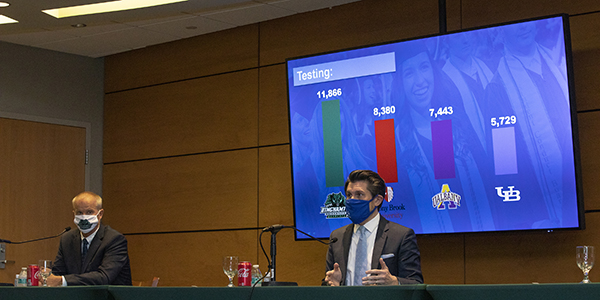Binghamton moves to remote instruction, chancellor visits

At 10:15 a.m. Wednesday, Oct. 7, Binghamton University President Harvey Stenger announced to the campus that the University would be proactive and begin a two-week period of remote instruction on Thursday, Oct. 8, due to a rising number of positive COVID-19 cases.
An hour later, Stenger was joined by SUNY Chancellor Jim Malatras and Broome County Executive Jason Garnar for a news conference to talk about the decision to move to fully remote instruction before reaching the threshold of 100 positive cases required by the state.
Though Binghamton had not yet reached the 100 threshold, positive cases are trending up and the decision was made to help reduce density, Stenger said.
“The campus will remain open and all core operations of the University will remain open,” he said. “We remain committed to in-person instruction for the fall semester and will work to make our transition back to in-person activities as quickly as we can under Department of Health guidelines while ensuring the safety of students, faculty, staff and our community.”
“The steps Binghamton has taken today are responsible and prudent,” said Malatras, who spoke about the broader SUNY-wide strategy for managing the pandemic.
“We have been talking regularly about what’s going on here [at Binghamton] and the state’s threshold is 100. Binghamton is currently at 89 cases and the previous two-week period had only 25, so this is potentially only one blip,” Malatras said. “The rolling average has gone up, but it looks like it’s trending down again, so we have to manage those cases as they come.
“This is part of larger issue you’re dealing with in Broome County and other parts of the state,” Malatras added. “The college average in the state is coming down over the last few days. We’re managing and controlling the virus and are good partners with the community. We all want to be rolling in the same direction.”
Garnar noted that the recent rise in numbers is not a result of what’s happening at Binghamton University.
“I believe what’s happened with the University’s numbers is because of what’s happening in the community, not the other way around,” he said. “The average age of a positive person in Broome County is 40, so it’s not students on campus, but we support what the University is doing.”
Malatras reiterated the message he has been giving around the state — that SUNY is following two basic concepts: monitor and manage.
“We monitor through testing and transparency and Binghamton has been testing from the beginning and doing it well,” he said. “To manage, we put out uniform compliance for all 64 SUNY campuses and we are focusing on mental health so all needs are being met. There are already pressures in the course of normal student life and the need is now more than ever so we’ve launched a comprehensive Reach Out SUNY mental health program. We also appointed a student advocate. Now, we have to take the pause and reduce some of our in-person activities.”
Binghamton has done a phenomenal job on testing, Malatras said, far and above any of the other University centers at Stony Brook, Albany and Buffalo. “And they are ramping up their testing to 800 a day, which is something to be proud of,” he said. “They also have a really good data dashboard. They’re doing the things they need to do to keep everyone informed.”
To reverse the upward trend of positive cases is up to the entire community, Malatras said. “It is all based on our actions. If we follow the plan, I think we will be highly successful and we will be in a much better position here. I hope this is a blip, but it is also a wakeup call to be extra vigilant because the virus spreads fast.”
“Binghamton University is incredibly important to this community for a number of reasons,” Garnar said. “This is the absolutely correct decision to make. It’s data driven, the right thing to do and good for this community. Everything we’re seeing here is the result of a data-driven, careful, proactive process.”
The University is looking at the data every day and wants to see those positive percentages go down, Stenger added.
“We’re not just randomly picking people for testing,” he said. “We’re actually looking at populations where the risk level may be higher. The downside is we find more positives, but the upside is we find where they are occurring.”
The bottom line, Malatras said, is COVID-19 exists in our society and we have to collectively work on it. “We’re all part of the same ecosystem and have one unified front, which is the way to manage this.”

